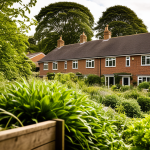Defining Sustainable Practices in UK Real Estate
Sustainable practices in UK real estate encompass strategies that reduce environmental impact while promoting energy efficiency and resource conservation. Key elements include using eco-friendly materials, improving building insulation, and integrating renewable energy solutions.
Common green building standards, such as BREEAM (Building Research Establishment Environmental Assessment Method) and EPC (Energy Performance Certificate), serve as benchmarks. BREEAM assesses aspects like energy use, waste management, and pollution during both construction and operation, providing an overall sustainability rating. EPC focuses specifically on a building’s energy efficiency, with higher ratings indicating lower energy consumption and reduced carbon emissions.
In parallel : Harnessing Sun Rays: Creative Property Design Tactics for Northern Climates
Regulatory requirements now increasingly encourage developers and homeowners to adopt these sustainable practices. For example, UK building codes demand minimum EPC standards for new constructions and major renovations. Additionally, several voluntary sustainability initiatives promote best practices beyond compliance, such as adopting circular economy principles or enhancing biodiversity on site.
Understanding these frameworks helps stakeholders evaluate and implement sustainable practices, supporting a market shift toward greener, future-proof properties. Implementing these approaches not only benefits the environment but also aligns with growing demand for sustainable UK real estate.
In the same genre : Harnessing Sun Rays: Creative Property Design Tactics for Northern Climates
Defining Sustainable Practices in UK Real Estate
Sustainable practices in UK real estate focus on reducing environmental impacts throughout a building’s life cycle. This includes energy efficiency, waste reduction, water conservation, and the use of environmentally friendly materials. Developers adopt green building standards to minimize carbon footprints while enhancing occupant health and comfort.
Among the most recognized green building certifications in the UK are BREEAM (Building Research Establishment Environmental Assessment Method) and EPC (Energy Performance Certificates). BREEAM evaluates buildings on aspects like energy use, materials, and ecology, providing ratings from pass to outstanding. EPC ratings gauge a property’s energy efficiency from A (most efficient) to G (least efficient), crucial for buyers assessing running costs and environmental effects.
Sustainability in UK real estate also aligns with evolving regulatory frameworks. The government mandates minimum EPC ratings for rental properties and promotes voluntary initiatives encouraging developers to exceed these standards. Schemes like the Green Homes Grant have historically supported renovation projects aimed at improving energy performance. Together, certifications and regulations drive the sector toward greener, more resilient building stock, appealing to environmentally conscious investors and occupants.
Market Trends and Buyer Demand for Sustainable Properties
Recent data reveal a significant rise in sustainable housing demand across the UK property market trends. Buyers increasingly prioritise eco-friendly homes, driven by growing environmental awareness and the desire to reduce energy costs. This shift is especially notable among younger demographics and urban professionals who value both sustainability and long-term savings.
Surveys indicate that properties with green credentials, such as high EPC ratings or BREEAM certification, attract more interest and tend to sell faster. Consequently, builders and developers respond by offering more sustainable options, reflecting how UK property market trends are evolving to meet this demand.
Demographic insights suggest that millennials and Gen Z buyers lead this trend, often seeking homes that align with their values on climate impact. Additionally, older buyers show increased interest in energy efficiency for cost reduction, illustrating that eco-friendly homes appeal across age groups.
These factors collectively drive market growth in sustainable housing, encouraging continued innovation in green building and renovation practices. Understanding these dynamics helps stakeholders adjust strategies to match evolving buyer expectations.
Market Trends and Buyer Demand for Sustainable Properties
The UK property market trends reveal a growing appetite for eco-friendly homes and sustainable housing. Recent data highlights that properties boasting sustainable features tend to attract higher interest, sell faster, and often achieve premium prices. This shift is largely driven by increased environmental awareness and rising energy costs, motivating buyers to seek homes with lower carbon footprints.
Sustainable housing demand is particularly strong among millennials and Generation Z, who prioritise environmental responsibility alongside lifestyle and comfort. These demographics influence market offerings, pushing developers to integrate eco-friendly designs and technologies. Additionally, city dwellers and professionals show preference for properties certified under recognised green building standards, such as BREEAM and EPC, which offer assurance on environmental performance.
Government policies encouraging sustainability also stimulate buyer interest. Voluntary sustainability initiatives highlight the benefits of UK real estate that surpass minimum regulatory requirements, appealing to eco-conscious investors. Overall, the trend towards sustainable and energy-efficient homes reflects broader societal values, shaping both current market dynamics and future expectations within the UK property sector.
Defining Sustainable Practices in UK Real Estate
Sustainable practices in UK real estate involve integrating eco-conscious methods throughout the development and operation of properties. These methods prioritize reducing environmental impact by focusing on energy conservation, waste minimization, and the use of renewable resources. Central to these practices are green building standards that establish clear criteria for sustainable construction and management.
Two key certifications widely recognized in UK real estate are BREEAM and EPC. BREEAM evaluates comprehensive aspects, including energy efficiency, material sourcing, and ecological impact, assigning ratings from Pass to Outstanding. Meanwhile, EPC rates a building’s energy consumption on a scale from A to G, directly reflecting its efficiency and carbon footprint. These benchmarks help property owners and buyers assess sustainability levels accurately.
Regulatory frameworks in the UK increasingly mandate minimum EPC standards for new and renovated buildings, pushing the market to adopt greener solutions. Beyond regulation, voluntary sustainability initiatives encourage enhancements like improved insulation or renewable energy integration, boosting environmental performance and occupant well-being. Together, these elements provide a robust foundation for embedding sustainable practices across UK real estate, fostering a more eco-friendly and resilient property sector.
Defining Sustainable Practices in UK Real Estate
Sustainable practices in UK real estate centre on minimising environmental impacts through the entire building lifecycle, from design and construction to operation. Key approaches include using energy-efficient systems, selecting materials with low carbon footprints, and conserving water. Such strategies align with broader goals like reducing emissions and enhancing occupant wellbeing.
Two primary green building standards widely recognised are BREEAM and EPC. BREEAM evaluates environmental performance across categories such as energy, waste, and ecology, assigning ratings that guide developers toward best sustainable practices. EPCs specifically measure energy efficiency on a scale from A to G, influencing market values and compliance with building regulations.
Regulatory frameworks in the UK mandate minimum EPC ratings for new and refurbished properties, aiming to phase out inefficient buildings over time. Beyond regulations, numerous voluntary schemes encourage adoption of sustainable practices that go further, like improving biodiversity or promoting circular economy principles. These frameworks and standards collectively support a transition to greener UK real estate, ensuring properties meet future environmental and market expectations while benefiting owners and occupiers alike.
Defining Sustainable Practices in UK Real Estate
Sustainable practices in UK real estate involve methods that minimize environmental impact while promoting resource efficiency. Central to these are green building standards like BREEAM, which assesses energy use, waste, and ecological impact, and EPC, which measures a property’s energy efficiency from A to G. These benchmarks guide developers and owners in creating and maintaining eco-friendly properties.
Regulatory requirements now play a key role. The UK government mandates minimum EPC ratings for new builds and major renovations to curb carbon emissions. This ensures that buildings achieve baseline energy efficiency, reducing long-term operational costs and environmental footprint. Beyond regulation, voluntary sustainability initiatives encourage enhancements exceeding minimum standards. These include improved insulation, water conservation systems, and integration of renewable energy technologies.
Together, these sustainable practices support a transition to greener, more resilient buildings. They align economic incentives with environmental responsibility, making sustainability a practical priority in the competitive UK property market. Through adherence to recognized green building standards, stakeholders can ensure properties meet both regulatory demands and rising buyer expectations for sustainability.
Defining Sustainable Practices in UK Real Estate
Sustainable practices in UK real estate focus on reducing environmental impacts through thoughtful design, construction, and operation methods. These include prioritising energy efficiency, using low-impact materials, and minimising waste. Central to these efforts are green building standards, which set measurable criteria to assess and improve property sustainability.
Prominent certifications such as BREEAM evaluate buildings on energy use, water management, ecology, and materials, assigning ratings from Pass to Outstanding. Similarly, the Energy Performance Certificate (EPC) rates energy efficiency on a scale from A to G, directly impacting a property’s market appeal and regulatory compliance.
UK regulations increasingly require minimum EPC ratings for new builds and major renovations to ensure properties meet energy standards. Beyond mandatory rules, voluntary initiatives encourage developers and homeowners to adopt more ambitious sustainability measures—like renewable energy integration or enhancing biodiversity—fostering a greener property sector.
Together, these frameworks promote consistent sustainable practices, enabling stakeholders to gauge environmental performance effectively while supporting the transition toward environmentally responsible UK real estate development and maintenance.
Defining Sustainable Practices in UK Real Estate
Sustainable practices in UK real estate focus on reducing environmental impact through energy conservation, resource efficiency, and eco-conscious design. Central to these practices are green building standards like BREEAM and EPC. BREEAM assesses a building’s environmental performance across multiple categories—including energy use, waste management, and ecological effects—awarding ratings from Pass to Outstanding. EPC, measured from A to G, evaluates energy efficiency specifically, influencing both regulatory compliance and market appeal.
Regulatory frameworks require minimum EPC ratings for new builds and significant refurbishments, ensuring a baseline of energy performance that reduces carbon footprints and operational costs. Beyond compulsory standards, voluntary sustainability initiatives encourage builders and owners to adopt enhancements such as improved insulation, renewable energy systems, and water conservation measures.
These combined efforts ensure sustainable practices extend beyond legal compliance, fostering resilient properties aligned with growing environmental priorities. Such standards and initiatives enable stakeholders to clearly evaluate and implement sustainability, supporting the transformation of the UK property sector into one that is greener and more resource-efficient.
Defining Sustainable Practices in UK Real Estate
Sustainable practices in UK real estate involve strategically minimizing environmental impacts while enhancing building performance. These methods include adopting energy-saving technologies, utilising low-carbon materials, and implementing water conservation measures. Central to this approach are robust green building standards, which provide clear guidelines and benchmarks for sustainability.
Two leading certifications in the UK property sector are BREEAM and EPC. BREEAM assesses buildings across categories like energy efficiency, materials, waste management, and ecological impact, awarding ratings from Pass to Outstanding. This comprehensive approach ensures sustainable practices extend beyond energy use. The Energy Performance Certificate (EPC) specifically measures a property’s energy efficiency on a scale from A (most efficient) to G (least efficient), influencing both market demand and regulatory compliance.
Regulatory mandates require minimum EPC ratings for new constructions and major refurbishments, driving widespread adoption of energy-conscious designs. Voluntary sustainability initiatives encourage further enhancements, such as integrating renewable energy technologies or improving biodiversity, that exceed mandatory standards. These combined frameworks create a structured pathway, supporting property owners, developers, and investors in embedding sustainable practices effectively into the UK real estate market.








